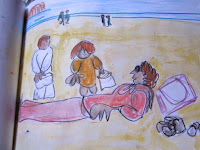King of Mars.
King of Mars was reading the
introduction of the thiner catalogue « NAVAJO SANDPAINTING
ART » that his new friend Josette, the espionne rousse du réel,
had lended him. The texts had been writed by EUGENE BAATSOSLANII JOE
and MARK BAHTI in 1978. « Well,
not a very fresh knowledge ! But actually it deals with such
old things that fifty years is like twelve seconds ! ».thought
King of Mars. « I wonder how the Navajo call my planet. I know
there's a confusion in french between the name of my planet and the
third month of the year .. well Time and Space are the same thing,
EINSTEIN is not french but had to read a french one to begin to think
properly ... »
So King of Mars read :
« According to the Navajo religion, the Universe is a very
delicately balanced thing, full of enormously powerfull forces, with
potentiel for good or evil. If this balance is upset, even
unintentionnnaly, some disaster – usually an illness- will result.
Further, it's believed that only Man can upset the balance.
To restore the balance or harmony
means performing one of the myriad Navajo Chants or Ways. These are
long and complex ceremonies that may last from one to nine days.
Involving the use of medecinal herbs, prayers, sandpaintings and
songs, these Ways recount a portion of Navajo legendary history that
relates to the particular illness and its cause. By ceremonially
identifyng with the hero of the myth in his eventual triumph, the
patient becomes stronger and harmony is restored, thereby effecting a
cure.
The scene is ancient as the Navajo
people The Setting is the traditionnal Navajo hogan, with Mother
Earth for a floor and the entrance facing east. The elders of the
tribe, in sitting cross-legged, awaken the silence with the shaking
of gourd ratlles and the chanting begins.
The sunstreams in through the
smokehole of the hogan, bathing the patient in its light. The
chanting continues, unfloding the exploits of one heroes of Navajo
legend.
The sandpainting is done in a
careful and sacred manner, according the ancient knowledge of the
art, with each figure, and each design in order and done with the
five sacred colors.
As the patient is seated atop the
completed sandpainting, the hatathli (medicine man) bends to
reverently touch a portion of a figure in the sandpainting, then
moves to touch the patient, transferring the medicine and the power.
As this is done, the sickness falls from the patient and harmony
returns.
Then, before the sun sets, the
sandpainting is erased with a sacred feather staff and is swept onto
a blanket to be carried outside and carefully disposed of. In casting
it away, the last of sickness is carried away from the patient, who,
healed throught faith, rises to walk in beauty once again. »
« Well, We do that quite
differently on Mars » said King of Mars, breathing with joy.
« Care must be taken to
perform the ceremony correctly, down to the smallest detail, lest
disaster befall all present. A medicine man's apprentice will spend
years learning a single Way before ever performing it himself.
(Navajo society is a matriarchal one, but even so, few women ever
become a hatathli.)
The importance of these ceremonies
to the Navajo should not be underestimated or demeaned. Over the last
two decades a number of doctors and hospitals serving the Navajo have
come to realize that to succesfully treat a Navajo patient it is
often necessary to do it in conjunction with a hatathli
Most ethnologists feel the Navajo
probably learned sandpainting from the Pueblo Indians who, fearing
reprisals from the Spanish after the Great Pueblo Revolt in 1680,
went to live among the Navajo. Since that time sandpaintings have
declined somewhat in importance among the Pueblo Indians, but have
been refined and evolved onto a vastly more complex level among the
Navajo, for whom it plays a major rôle in their religion.
According to Navajo history,
however, the Dinneh were first shown the art of sandpainting as part
of their ceremonial instruction from the Holy ones, who were never
seen by human eyes. Instead they became known only through the
instructions they relayed through the spirits, such as the Wind
People, who passed on knowledge of the ceremonail songs to the
Navajo.
Among the sacred knowledge given
the first apprentices, during the seven days ans seven nights of
their purification and instruction, were songs, prayers and
sandnpainting, as well as medecine tools – objects and plants with
protective or curative powers.
The ceremonial paintings which were
revealed to them were painted on scrools made of Moutain Sheep skin,
but they were told they must do the sandpainting with sand, on Mother
Earth, to prevent the knowledge from being hoarded and to insure that
anyone wth the necessary ability and patience might learn them. As
the Holy People told them :
We will not give you this picture
Men are not as good as we
They might quarrel over the
picture and tear it
and they would bring misfortune ;
The black cloud would not come
again,
and the rain would not fall ;
the corn would not grow.
but you may paint it on the
ground,
with the colors of the earth »
King
of Mars has fallen asleep during his reading. He's dreaming now. He's
flying in the sky like an eagle.




Commentaires
Enregistrer un commentaire